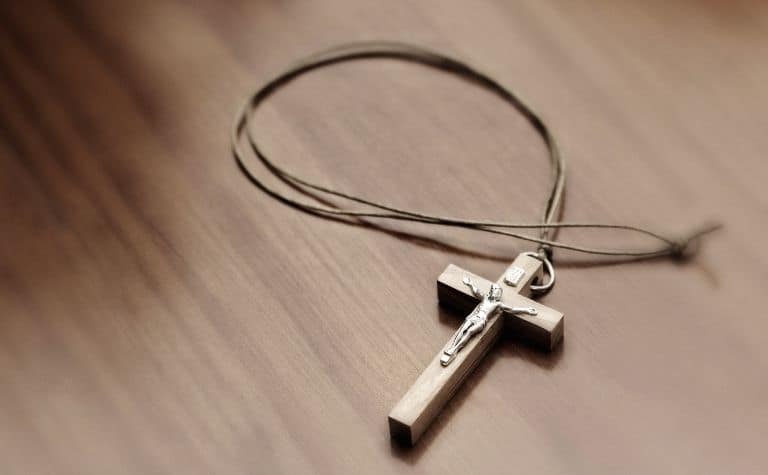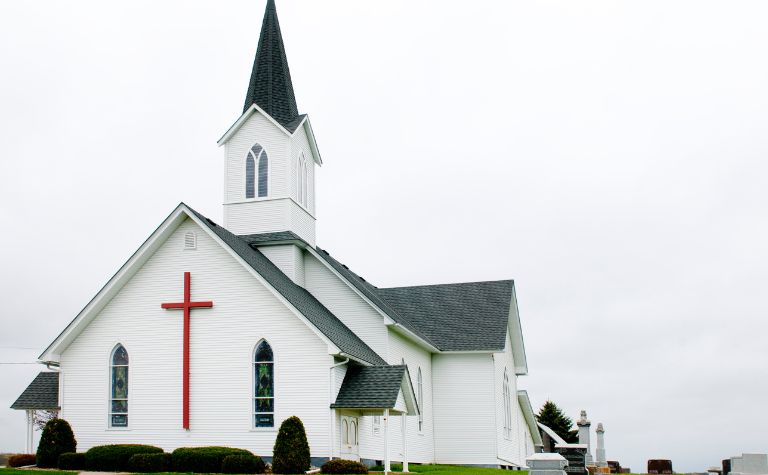Crucifixes — a cross with a physical representation of Jesus Christ nailed to it — is one of the most notable symbols in the Roman Catholic Church. Crucifixes are the centerpiece of sanctuaries, hang on the walls of people’s homes, and are displayed as pendants on jewelry. But why don’t Protestants revere and similarly use crucifixes?
Most Protestant traditions prefer the symbol of an empty cross because it reminds them that Jesus is alive. Some Protestants also believe that any physical representation of Jesus violates the second commandment. A minority of Protestants don’t have these convictions and display crucifixes.
Why are some Protestants so passionately opposed to crucifixes? Is a crucifix a violation of the second commandment? Which Protestant Reformer used crucifixes? Which one was adamantly opposed to them? Keep reading to learn more.

Crucifix Controversy: Crucifixion and Resurrection
Protestants believe that the death of Christ on the cross enables salvation for sinners. Theologically, this belief is often referred to as atonement. (Also see Why Do Protestants Use Grape Juice at Communion?)
Most Protestant traditions believe that the Bible teaches that Christ died as a penalty for sin and in place of sinners (e.g., Rom. 6:23). So why don’t Protestants want to memorialize this with a crucifix?
What do Protestants want to memorialize with an empty cross? Historically, Protestants emphasize celebrating the resurrection of Christ and believe that an empty cross depicts that reality.
The death of Christ is a wonderful reality and should be remembered with great humility and thankfulness on a daily basis, yet it isn’t the end of the story.
Christ’s resurrection declares his victory over death and enables the resurrection of people (1 Cor. 15:42-44). (Also, see Protestant vs. Pentecostal: What’s the Difference?)
Key term | crucifix: The English word “crucifix” comes from the Latin word “crucifixus,” which combines “cruci” and “fix,” meaning “one fixed to a cross.”
Is a crucifix sinful according to Protestant theology? Though most Protestants prefer the depiction of an empty cross, not all believe that a crucifix is sinful.
Others, however, believe that any physical representation of Christ, on a cross or not, is a violation of the second commandment and is, therefore idolatrous and sinful (see below).
Not even the Protestant Reformers (e.g., Martin Luther and John Calvin) agreed about using crucifixes (see below). (Also, see Protestant vs. Reformed: What’s the Difference?)

Is A Crucifix Idolatrous?
Some Protestants are persuaded that any physical representation of God, even of Christ in the flesh, is a violation of the second commandment that God gave Moses, as recorded in Exodus 20:4. (Also see Do Protestants Believe in Transubstantiation?)
In this way of thinking, any man-made image of God drastically fails to reflect him with accuracy and diminishes his glory. What exactly does the second commandment say?
- King James Version: “Thou shalt not make unto thee any graven image, or any likeness of any thing that is in heaven above, or that is in the earth beneath, or that is in the water under the earth.”
- English Standard Version: “You shall not make for yourself a carved image, or any likeness of anything that is in heaven above, or that is in the earth beneath, or that is in the water under the earth.”
- New Revised Standard Version: “You shall not make for yourself an idol, whether in the form of anything that is in heaven above, or that is on the earth beneath, or that is in the water under the earth.”
The argument that crucifixes are idolatry often makes the following points:
Crucifixes hide God’s glory: Images of Christ’s death on the cross may reflect a moment in history, but they obscure God’s glory. The term “glory” describes God’s unending beauty that leads people to know and worship him.
“Glory” in the Bible describes God’s character and deeds. To some Protestants, crucifixes dim the light of God’s beauty. (Also see Do Protestants Have Confession?)
Crucifixes hide God’s character: To some Protestants, one of the great dangers of images of Christ is that the person imagines the depiction while praying. If a person imagines God in their mind the way he is portrayed in a piece of art on wall decorations or on a necklace, that is idolatry.
Some may object, “But that image only represents Christ,” to which Protestant theology would say, “A representation isn’t good enough when it comes to God.” (Also, see Protestant vs. Evangelical: What’s the Difference?)
Crucifixes hide God’s victory: The clear teaching of the New Testament is that Christ rose from the dead three days after his crucifixion. The Gospel stories conclude with Christ’s resurrection, not his death. His body no longer hangs on a cross because he physically rose to new life.
To some Protestants, crucifixes don’t tell the end of the story. However, empty crosses serve as a reminder of Christ’s resurrection. (Also see Why Do Protestants Worship on Sundays?)
While some Protestants are persuaded that these arguments are true, those who use the images in worship, as decoration, on pendants, and in other displays don’t believe they are breaking the second commandment. Those who use crucifixes don’t believe they are rebelling against God; they believe they are honoring him.
Didn’t Christ choose to physically represent God when he became flesh? Catholics, and some Protestants, argue that when Christ became a human being, he assumed a physical form, so it is permissible for people to remember him in that way.
Others counter that since no one knows what Christ really looked like, any depiction of him comes from someone’s imagination. Furthermore, it is best to memorialize his current resurrected state. (Also see Why Don’t Protestants Use Crucifixes?)
Do Other Protestants Use Crucifixes?
Crucifixes are most common in the Roman Catholic and Eastern Orthodox traditions, where they are found in church sanctuaries, in pictures and paintings, and on personal items like jewelry and rosary beads.
Key term | rosary: The rosary is a devotional prayer in Catholicism, which includes the Hail Mary and the Lord’s Prayer. The word also describes the string of beads that Catholics use to aid them in praying.
Most Protestant traditions reject using crucifixes because they believe it violates the second commandment and for the other reasons already mentioned. However, some Lutheran and Anglican churches utilize crucifixes in corporate worship and for personal use, such as prayer. (Also, see Protestants vs. Anglicans: What’s the Difference?)
Crucifixes in Lutheranism
Martin Luther, the 16th-century German Reformer, displayed crucifixes in Lutheran churches. Luther believed that it was possible for people to use images of Christ in inappropriate ways, but there are right ways to use them. (Also, see Protestants vs. Lutherans: What’s the Difference?)
Luther believed that images of Christ are not inherently corrupt. He wrote, “Should it not be as possible for us without sin to have a crucifix or an image of Mary, as it was for the Jews and Christ himself to have an image of Caesar who, pagan and now dead, belonged to the devil? Indeed the Caesar had coined his image to glorify himself.”
He continues, “However, we seek neither to receive nor give honor in this matter, and are yet so strongly condemned, while Christ’s possession of such an abominable and shameful image remains uncondemned.” [1] (Against the Heavenly Prophets, 1525; LW, Vol. 40, 96)
Luther believed that a crucifix or another physical representation, whether it be of God or of Mary, for example, can be used to remember a person or an event. In other words, Luther drew a distinction between using images to remember and using images to worship.
He writes, “[M]y image breakers must also let me keep, wear, and look at a crucifix or a Madonna . . . as long as I do not worship them, but only have them as memorials.” (Ibid., 86, 88)
“But images for memorial and witness, such as crucifixes and images of saints, are to be tolerated . . . And they are not only to be tolerated but for the sake of the memorial and the witness they are praiseworthy and honorable . . .” (Ibid., 91)

John Calvin Believed That Using Crucifixes Was Wrong
The French Reformer John Calvin, who was instrumental in establishing the Presbyterian church and articulated much of Reformed theology for the Protestant church, agreed with Luther on many things, but using crucifixes wasn’t one of them. (Also, see Protestant vs. Reformed: What’s the Difference?)
Calvin believed that images like crucifixes hide the glory of God: “We think it unlawful to give a visible shape to God because God himself has forbidden it, and because it cannot be done without, in some degree, tarnishing his glory.” (The Institutes of the Christian Religion, I, 11:12)
Calvin established his argument, in part, on the second commandment: “In the Law, accordingly, after God had claimed the glory of divinity for himself alone when he comes to show what kind of worship he approves and rejects, he immediately adds, ‘Thou shalt not make unto thee any graven image or any likeness of any thing that is in heaven above, or in the earth beneath, or in the water under the earth’ (Exod. 20:4). By these words he curbs any licentious attempt we might make to represent him by a visible shape…” (Ibid, I, 11:1)
In a sermon on Deuteronomy, Calvin implored people not to use images of Christ: “Should we have portraitures and images, whereby only the flesh may be represented? Is it, not a wiping away of that which is chiefest in our Lord Jesus Christ – that is, to wit, of His Divine Majesty? Yes!” (Sermon on Deuteronomy 4:15-20) Calvin also believed Christians shouldn’t utilize empty crosses corporately or privately.
References:
[1] Source
[2] Source
[3] Source
Related Questions
Catholic vs. Protestant vs. Orthodox: What's the Difference?
Roman Catholicism, Protestant Christianity, and the Eastern Orthodox Church are the three historical branches of the Christian religion. Each tradition traces its doctrines and practices to the New...
Protestantism and Anglicanism are branches of the Christian faith that have roots in Europe. Protestantism and Anglicanism have similarities and differences with each other as well as other...
